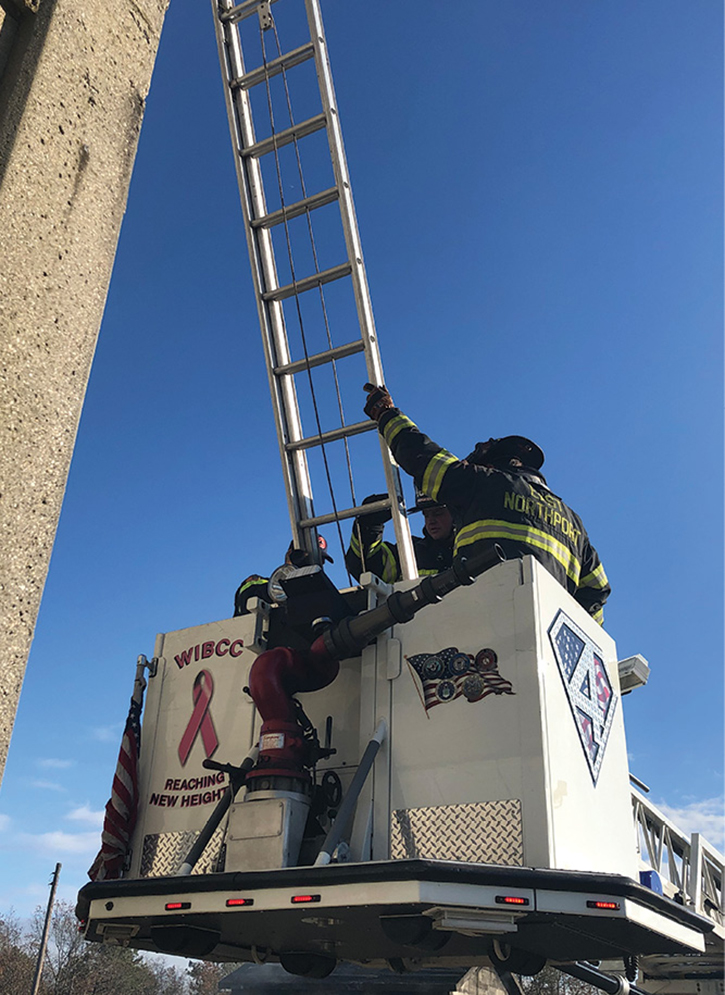
Fires in high-rise buildings often occur on the upper floors, out of reach of the aerial apparatus. Responses to an injured worker in a tree or an industrial complex with high silos, smokestacks, or exterior catwalks may be out of reach of the aerial as well. Sure, numerous manufacturers make aerial apparatus capable of reaching greater heights, but most departments aren’t equipped with them. Plus, today’s ever-changing landscape is full of cell towers and electronic billboards, often necessitating responses to incidents involving an injured or a stranded worker. The worker may be difficult to remove or access when the fire apparatus ladder comes up short of the objective.
RELATED
Training Minutes: Extending a Tower Ladder
Chauffeur Training for the Tower Ladder
Training Minutes: Rescue Tips from the Tower Ladder Bucket
We’re also seeing an increase in low-rise (five- to seven-story) multiple dwellings. Can your aerial apparatus reach such buildings and their roofs? Many of these structures have setbacks, canopies, or deep courtyards in addition to sidewalks and large parking lots with landscape planters. In a fire with a person trapped in a window, the aerial device may not be able to achieve optimum position because of one of these obstacles and will come up short.
Hopefully, if you encounter such a situation, your department has a life-saving rope evolution as part of your standard operating procedures. In the case of coming up short with a tower ladder, there is an evolution that firefighters should drill on so they can increase the reach of their tower ladders by using a portable ladder from the bucket for access, removal, or rescue. Firefighters should train on it to be prepared for this unlikely occurrence.
Tower Ladder Boom and Bucket
To see if your tower ladder can perform this maneuver, look at the physical makeup of the bucket and boom. For tower ladder units with a solid boom, the bucket should have a sturdy structural member at the rear floor of the bucket; this can be a piece of tubular steel or steel angle iron. Some tower ladder apparatus have a flat floor at the rear of the bucket with no lip so a firefighter can easily transition from the ladder into the bucket.
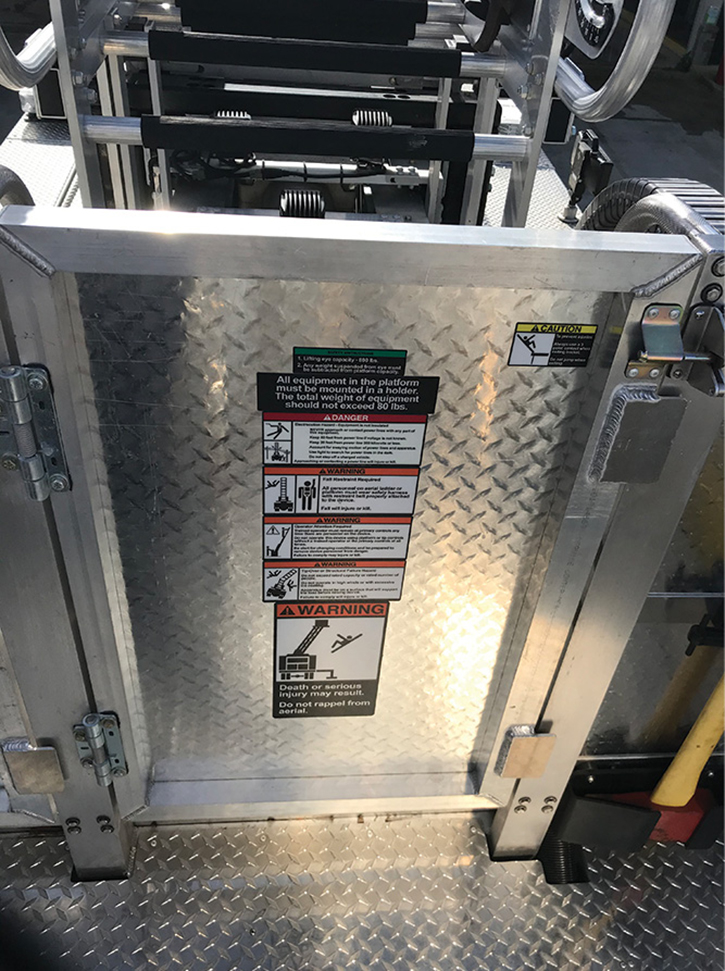
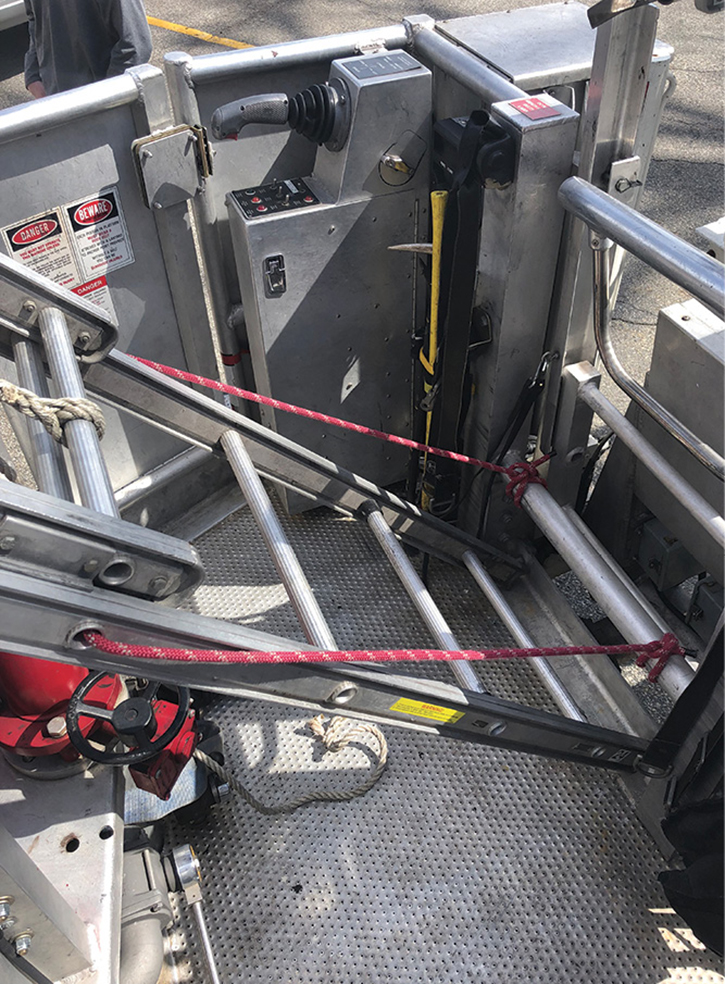
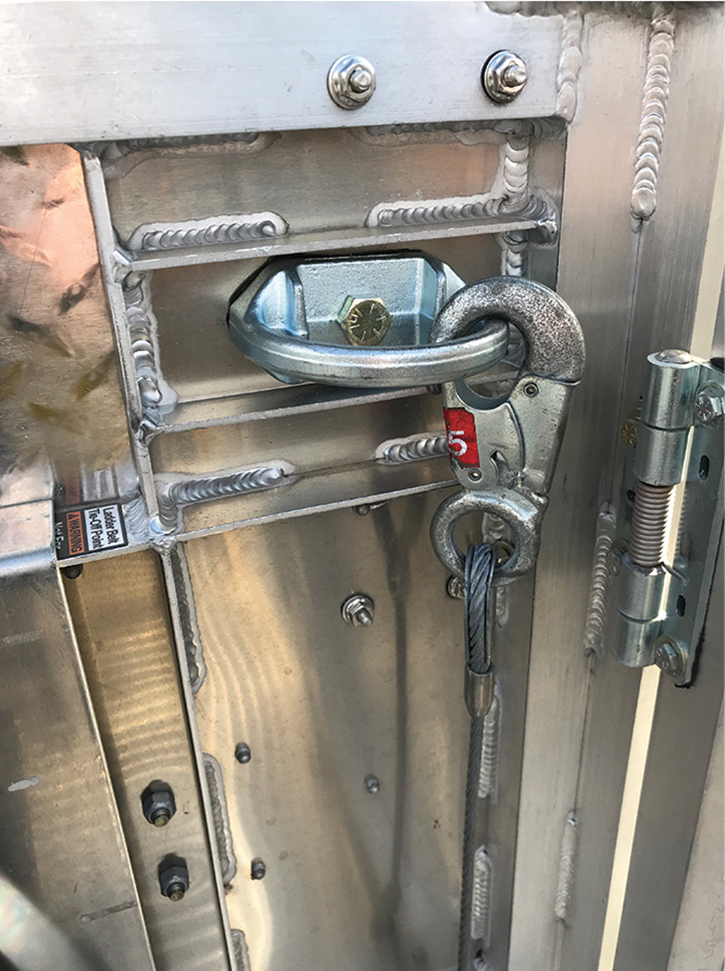
(1) Prior to using this tactic, have an understanding of the tower ladder bucket’s rear floor physical characteristics for butting the ladder. (Photo by J.J. Cassetta.) (2) Always tie off the ladder to a substantial object to ensure there is no movement. Having a presized rope or webbing will assist in a quick setup. (Photo by Kevin Ciampo.) (3) Using a provided tie-off point is also a good place to secure the rope, webbing, or cable. (Photo by J.J. Cassetta.)
Look for a solid base at the rear floor of the bucket to place the butt of the portable ladder up against. If there is a solid metal tubular or angle iron on the back floor, the ladder can butt right up against that. In the case of the open area for a ladder tower, running a 4- × 4-inch wood block from your cribbing inventory across the back of the bucket’s floor will act as the portable ladder’s physical butt. Ensure the piece of wood spans the entire opening of the bucket’s access point so it is supported by a structural member on each side of the bucket’s floor to prevent the cribbing from moving, twisting, or sliding out of position. If the tower ladder has an angle iron back plate, you can also use a 4 × 4 to “beef up” the base.
The flooring in most tower ladder buckets is solid metal with small holes or grooves to allow water to drain and to prevent ice buildup, but some still have an open grating style floor. If you’re placing the ladder on such a floor, attempt to have the portable ladder’s butt against the rear of the bucket and ensure the front of the butt sits in the same grating groove so it is not twisted and weight will be distributed evenly.
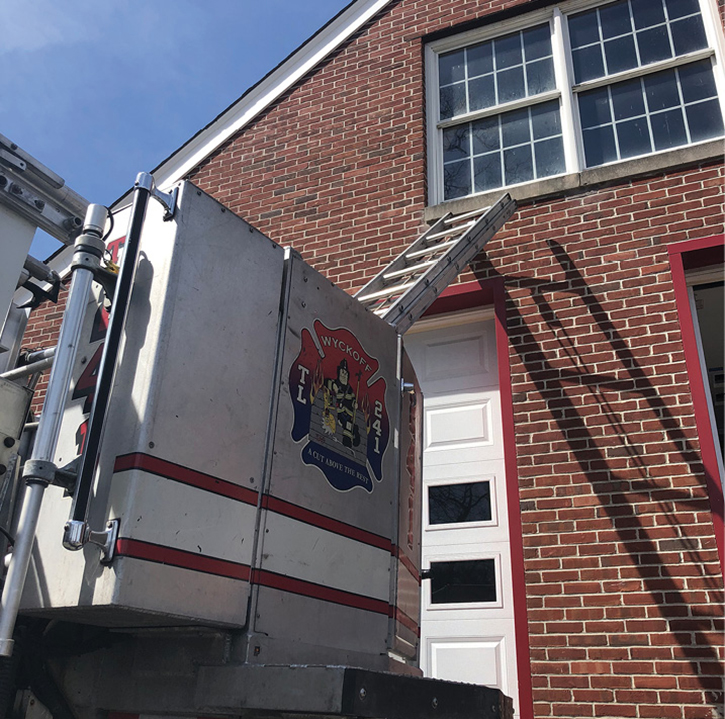
(4) When positioning the ladder to the building, ensure you have both tips resting on the building to distribute the weight equally. Otherwise, the portable ladder may twist while you are climbing it. (Photo by Kevin Ciampo.)
Portable Ladder and Bucket
Choosing the right size portable ladder for the operation may be one of the toughest decisions to make. First, you’re going to have to know the reach of your apparatus and how much distance you need to make up since you’re short of the objective. If the distance isn’t a large amount, a shorter combination A-frame extension ladder is all that you may need. If it’s a longer distance, you’ll have to use an extension ladder. In most cases, choosing the two-section 24-foot extension ladder will be easier—it is 14 feet when bedded and lighter than a two-section 35-foot extension ladder, which is 20 feet closed and heavier.
There may be instances where you can safely extend the reach of the tower ladder by using a suitcase/folding ladder from the bucket. Many tower ladders have these ladders attached to the boom or onto the ladder’s fly section so firefighters can deploy them over a high parapet and safely gain roof access. Although narrow to climb and operate on, these ladders are lightweight and maneuver easily if you’re working around obstructions such as tree limbs or scaffolding.
Once you choose the appropriate length ladder, you have to decide if you want to lift it up into the bucket vertically using the strength of firefighters on the ground and in the bucket or an easier option of positioning the bucket on the ground and placing the portable ladder in it at ground level. The first option can be difficult to do if there aren’t enough firefighters assisting in the lifting process; use caution and request help if this is your only option. It may be your only choice if there isn’t room to place the bucket off the side of the apparatus because of physical obstructions or the area is too narrow in which to operate. The second option is easier but requires more time, which you may not have if an individual is trapped at a window under heavy smoke conditions.
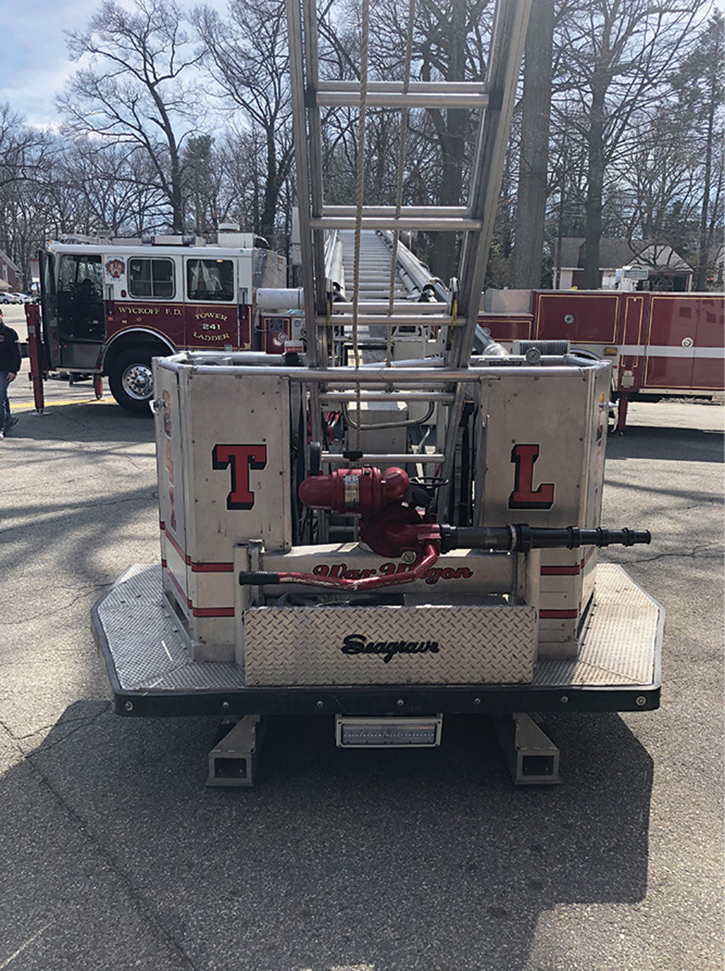
(5) Moving the master stream device to the lowest position in this bucket keeps it out of the way and allows an easy climb and descent. (Photo by Kevin Ciampo.)
Once the ladder is in the bucket, ensure that the ladder’s butt is physically supported at the rear bucket flooring using a method described above. It is also a good idea to have a dedicated piece of rope that is only used for tying the bed section of the ladder off to the safety eye hooks, a structural member, or the rear of the bucket. Don’t tie off to an area where the bucket will self-level and cause the ropes to move; it needs to be secured to prevent it from moving and sliding. Tying off just the bed section of the ladder allows you to extend the fly section of the portable ladder, which gives you another chance of having varying heights when you’re operating from below the victim. When using the securing rope, place it through the ladder’s rung and out the other side; this keeps the rope off the rungs and lessens the chances of becoming a tripping hazard for a climbing or descending firefighter or victim.
If you use a folding/suitcase ladder, you may have to secure it differently since it doesn’t have open-ended rungs. You may have to tie the securing rope directly to the ladder’s rung and beam to keep it in position. Depending on to what and how you tie off the rope, you may have to step over it to access any type ladder at its base. The other firefighter in the bucket should support you while you transition from bucket to ladder. Once you are on the ladder, you can disengage the approved safety belt and climb the ladder to operate or retrieve a trapped individual. It is always recommended that you wear a personal safety harness or belt so if you need to you can secure yourself to the portable for your overall safety.
When the tower ladder bucket comes up short, it usually does so from below the victim. Be careful when coming from below to encourage the victim to “stay put.” As you raise the portable ladder, you want the front of the bucket to be square to the building so both ladder beams will rest on the building, supporting it and reducing the chances of it twisting or moving. Plus, the ladder is designed to be supported at the top and bottom, which it will now be.
Raising the halyard may be a little difficult to do when the ladder is secured to the bucket because the halyard is usually on the underside of the ladder. Use caution with your arms when pulling the halyard downward; you don’t want to bang into any of the controls, structural bucket members, or master stream device inside the bucket. It would also be good policy to shut off the master controls in the bucket once the portable ladder is in position and you begin to climb it so there’s no possibility of hitting the control and moving the bucket during this evolution.
For an injured worker in a tree, the two beams might not sit on the tree. The ladder’s top rung may have to sit on the tree as the upper support while the two beams are suspended in mid-air. Be aware prior to climbing that the ladder’s tip may slide to one side or the other until one beam wedges up against the tree. The same applies to operating at an industrial complex with steel columns and catwalks; use caution.

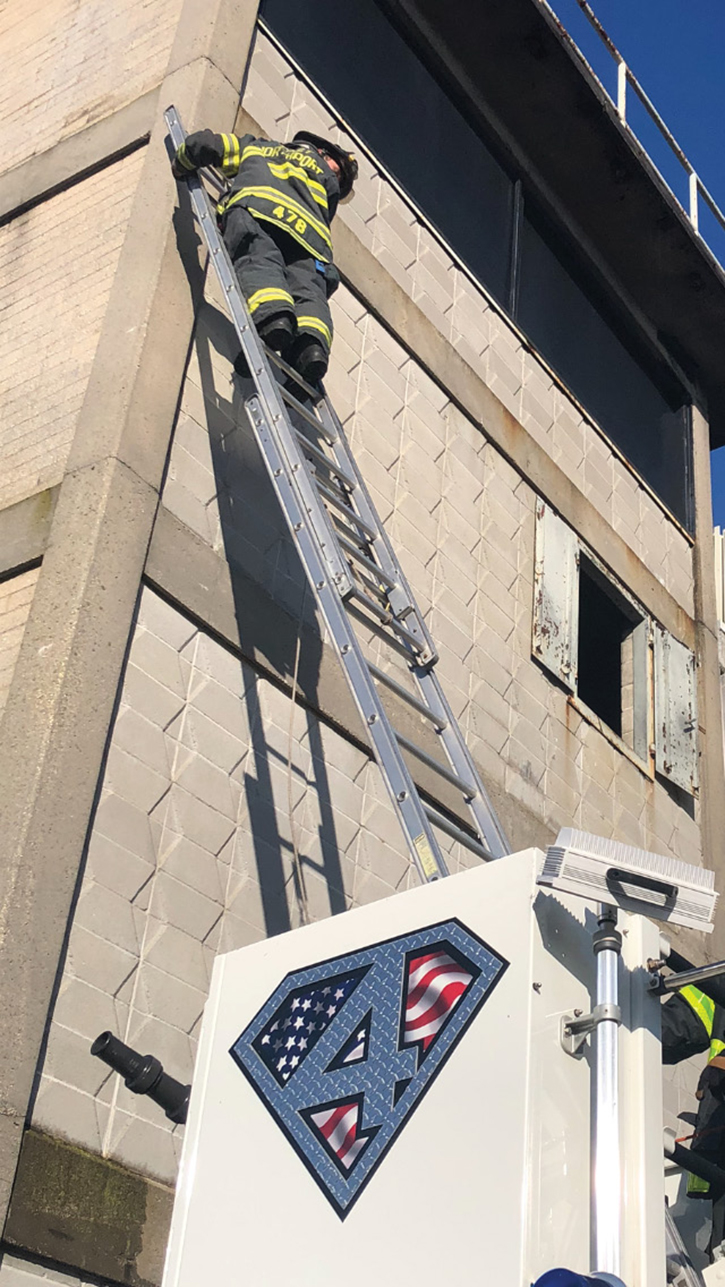
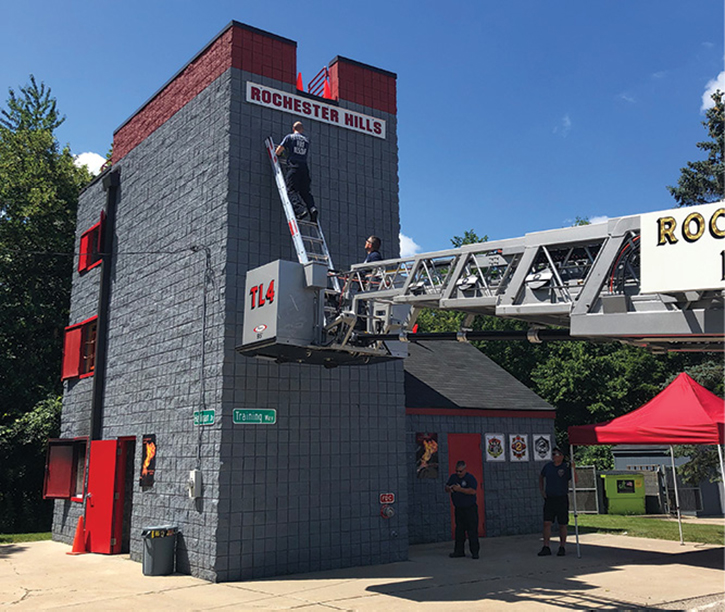
(6) Ensure that the ladder won’t hit the bucket’s controls; this bucket’s controls were moved out of the center to allow the ladder to sit properly. (Photos 6-8 by J.J. Cassetta.) (7) The portable ladder is resting on the rung, simulating the rescue of a victim in a tree, which you may have to do in a lifesaving operation. Always inspect ladders after their use. (8) You may have to extend the tower ladder boom under an overhead obstruction and may not be able to increase its elevation, so you may have to use the portable ladder to complete the rescue operation.
An important safety item is that as you begin to climb the portable ladder, immediately check the ladder locks to ensure they are both in the locked position prior to climbing past them.
You might have to assist the victim from the window onto the portable ladder, which can be a very dangerous operation. Hopefully, the victim can maneuver onto the ladder and out the window with little help and you just may have to support him during the descent to the bucket.
In some cases, the victim may be able to shelter in place as the hoseline knocks down the main body of fire. It is far less dangerous to keep the victim in the window, be verbally supportive, and share some air off your self-contained breathing apparatus than to have him climb downward. If this is not an option, use all your strength to help the victim transition onto the ladder and climb downward. Ensure you’re close enough to control his speed of descent; you want a fluid and smooth speed so you both don’t trip over the safety rope when you get to the base of the ladder in the bucket. Also, maintain your hands on the backside of the ladder’s beams and not the rungs while climbing downward; this enables you to maintain four points of contact.
A construction accident or injured worker trapped in a precarious position may require you to operate in a precarious position. Such incidents may require two aerial devices—one, a tower ladder—to support, extricate, or remove the victim.
Other Considerations
This lifesaving method is primarily a last-ditch effort and used when no other means are available for a tower ladder unit to perform. Have prior training and knowledge of the physical makeup and characteristics of your specific apparatus before engaging in such an activity.
If the tower ladder you have has only stationary controls mounted to the front railing of the bucket, ensure the portable ladder isn’t hitting any of the controls or switches. If the control box is not permanently mounted, slide it to one of the sides of the bucket or remove it from the front so the ladder doesn’t come in contact with it. This will lessen the chances of resting on the box and damaging it. Always ensure these controls are shut down when climbing the ladder.

(9) Rescuing a tree trimmer stuck in a tree is just one unusual circumstance you may face that necessitates use of the tower ladder. (Photo by Tim Olk.)
Once the ladder is in contact with the building, the tip should be well supported but still able to slide side to side when a person attempts to climb out onto the ladder. Another way to keep the ladder stationary is to tie it to the front railings.
Throwing the ladder with the fly out makes the halyard a bit difficult to pull from underneath while working in the bucket. Placing the ladder with the fly under the bed section goes against the portable ladder manufacturer’s recommendations, as can be seen by the safety and operational stickers on the ladder.
Placement of the portable ladder should be done only inside the bucket. Placing the ladder on the front lip of the bucket doesn’t allow enough room for a firefighter to get on or off the ladder. Plus, the master stream device mounted to the front of the bucket is another obstacle to deal with.
After performing this tactic, firefighters and appropriate members of fleet maintenance should inspect the apparatus to ensure no damage occurred to the bucket or railings.
When raising the portable ladder, ensure you’re a safe distance from wires and other obstructions. Size up the building’s wall; brick mortar joints could impede the raising operation.
When traveling with the ladder, it is best to have it in the closed position. When it is extended, it is more likely to strike an object and could cause more stress on the ladder and machinery.
Using this tactic doesn’t always have to mean the tower ladder is being used at its maximum height; it may entail that it’s extended outward to its maximum reach and more height is needed from that vantage point (e.g., a billboard set off the roadway, where apparatus can’t navigate the terrain to get close enough to operate).
Firefighters operating in the bucket should always wear approved safety belts that are permanently attached to the bucket or wear personal safety harnesses. They can leave them disengaged when initially positioning the portable ladder in the bucket but they should secure themselves as soon as possible prior to any movements of the boom.
Although most fire departments may never have to perform this maneuver, they may face an unusual fire or rescue that will require using it. It is far better for a tower ladder company to train on this tactic in advance than to try using it without having a general understanding of how it will work with their apparatus.
MICHAEL N. CIAMPO is a 34-year veteran of the fire service and a lieutenant in the Fire Department of New York. Previously, he served with the District of Columbia Fire Department. He has a bachelor’s degree in fire science from John Jay College of Criminal Justice in New York City. He is the lead instructor for the FDIC International Truck Essentials H.O.T. program. He wrote the Ladders and Ventilation chapters for Fire Engineering’s Handbook for Firefighter I and II (Fire Engineering, 2009) and the Bread and Butter Portable Ladders DVD and is featured in “Training Minutes” truck company videos on www.FireEngineering.com.

